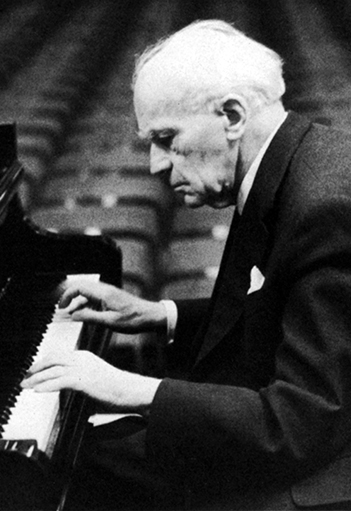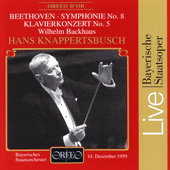Wilhelm Backhaus
Backhaus began his training at the Leipzig Conservatory at the age of ten under Alois Reckendorf. He then had some lessons for around a year with Eugen d’Albert in Frankfurt, but after this received no more formal training. Although he had played in public since he was eight, he made his professional debut in 1900, following it with a tour. He had, by this time, a large repertoire of more than 300 pieces and at least twelve concertos. At his London debut he played Mendelssohn’s Piano Concerto No. 1 in G minor Op. 25 and Brahms’s Variations on a theme by Paganini Op. 35. A year after this he substituted at short notice for Alexander Siloti at one of the Hallé concerts in Manchester, and three years later took up a post as professor of piano at the Royal Northern College of Music in Manchester. In the same year Backhaus won the prestigious Anton Rubinstein Prize in Paris, adding a further boost to an already burgeoning career as a pianist that continued until a few days before his death.
Backhaus continued touring Europe, and a programme from a 1911 British tour shows the repertoire he favoured at that time. He began with Beethoven’s Piano Sonata Op. 111, followed it with Chopin’s Piano Sonata in B minor Op. 58, and continued with a Chopin group containing études, waltzes, a nocturne, a prélude and the Scherzo in C sharp minor Op. 39. The recital ended with Debussy and Liszt. Not long after this he decided to play in the USA. For his debut he chose Beethoven’s ‘Emperor’ Concerto which he played with the New York Philharmonic Orchestra and Walter Damrosch at Carnegie Hall. He returned to Germany for the duration of World War I and took Swiss citizenship between the two world wars.
During Backhaus’s early career his repertoire was based around Chopin, Liszt, Schumann, Brahms and Beethoven, but during the 1930s he was already favouring more homogenous programmes. A Queen’s Hall recital from 1938 consisted of just three works, in variation form: Beethoven’s ‘Diabelli’ Variations Op. 120, Bach’s ‘Goldberg’ Variations BWV 988 and Brahms’s Variations on a theme by Paganini Op. 35. Apart from the utter reliability of Backhaus’s pianism, his playing had incredible integrity and conviction. It was always devoid of any personal idiosyncrasies, yet one can detect a difference in his recordings made after World War II. They have a more solid seriousness about them as he began to discard Chopin and Liszt from his programmes in favour of the German Classicists; his playing seemed to become more prosaic and less emotionally involved.
Backhaus was one of the pioneer pianists of recording. He became one of three pianists to join the roster of The Gramophone Company/HMV when he began to record in September 1908. The other two were Mark Hambourg and Percy Grainger. Grainger defected to Columbia and Hambourg continued to record for the company until 1936, when producer Walter Legge gained control of some aspects of the company. Backhaus was a pioneer in more ways than one, as after recording eleven sides he then made the first-ever recording of a piano concerto (by Grieg), in July 1909. It is heavily abridged (lasting just over six minutes) and it is interesting to note that HMV did not record another piano concerto until 1922. These early discs, recorded just three years after Backhaus’s win at the Anton Rubinstein Competition, display all his youthful vigour, poetry and amazing technique. All these acoustic recordings have been reissued on compact disc by Pearl.
World War I put a stop to Backhaus recording for HMV in London, and his next discs were made for Polydor in Berlin in 1916. They are some of his finest: he was thirty-two at the time, and he recorded one of his specialities, Brahms’s Variations on a theme by Paganini Op. 35. It was abridged to fit onto two 78rpm sides (though when he returned to HMV after the war he recorded the work again in 1924, and electrically in 1929). The fluidity of his technique is breathtaking; he never sounds under duress and the Polydor discs have remarkably good sound, making this one of the best of his early recordings. All the Polydor discs have been reissued on compact disc.
Backhaus continued to record for HMV until 1948. The 1920s saw the production of such classic recordings as that of Beethoven’s Piano Concertos Nos 4 and 5 (Backhaus stating at the time that his version of the ‘Emperor’ was the recording he would most like to be remembered by) and the first complete recording of the Chopin études in 1928, whilst from the 1930s comes one of the most glorious versions of Schumann’s Fantasie in C Op. 17. The sweep, grandeur and powerful conviction of this interpretation make it still one of the best on record. The same decade produced Backhaus’s famous Brahms recordings; both piano concertos and much of the late solo piano music are given authoritative performances. Also from this time comes a superlative Grieg Piano Concerto, with the New Symphony Orchestra conducted by John Barbirolli, and this time it was recorded complete. This excellent performance is like a breath of fresh Scandinavian air as Backhaus does not linger or sentimentalise the work and sets the last movement off at a terrific pace. The last sessions for HMV, recorded in Zürich and supervised by Walter Legge, produced an effective Italian Concerto of Bach.
Backhaus continued to record, this time for Decca, and now his recordings were issued on LP. One of the first things he embarked on was a project to record all thirty-two of Beethoven’s piano sonatas. After completing this, he recorded them again in stereo, but at the time of his death he had recorded only thirty-one, so the stereo version is not quite complete. He also recorded much of his core repertoire again: both Brahms’s concertos, all of Beethoven’s except No. 1, and some Schumann, Schubert and Mozart. Works he had not previously recorded include Beethoven’s ‘Diabelli’ Variations Op. 120 and Chopin’s Sonata in B flat minor Op. 35 plus an impressive Bach LP containing the English Suite No. 6 and French Suite No. 5.
Backhaus kept up his technique into his old age and was programming Chopin études as late as the 1950s. He said that scales were the basic foundation of his technique and to keep it in optimum condition he would practise them twice a week. Perhaps one of the most important later recordings is that of a live recital at Carnegie Hall from March 1954 where a seventy-year-old Backhaus delivered no less than five Beethoven sonatas.
© Naxos Rights International Ltd. — Jonathan Summers (A–Z of Pianists, Naxos 8.558107–10).



















